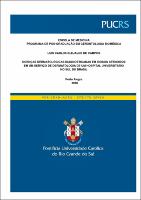| Share record |


|
Please use this identifier to cite or link to this item:
https://tede2.pucrs.br/tede2/handle/tede/8773| Document type: | Dissertação |
| Title: | Doenças dermatológicas diagnosticadas em idosos atendidos em um serviço de dermatologia de um hospital universitário no Sul do Brasil |
| Author: | Campos, Luis Carlos Elejalde de  |
| Advisor: | Terra, Newton Luiz |
| Abstract (native): | INTRODUÇÃO: A investigação diagnóstica, tratamento e prevenção das doenças dermatológicas geriátricas são de suma importância para que o idoso também tenha uma boa qualidade de vida. OBJETIVO: Avaliar os diagnósticos dermatológicos, sexo e raça e os itens fototipo, fotodano e fotoproteção nos idosos incluídos no estudo. MÉTODOS: Estudo transversal, descritivo e analítico que incluíram os idosos em primeira consulta no Ambulatório de Dermatologia do Hospital São Lucas da PUCRS, no período de março a novembro de 2017. Dados referentes ao diagnóstico dermatológico, sexo, raça, profissão, fototipo, fotodano e fotoproteção foram incluídos no instrumento de pesquisa. A análise descritiva das variáveis quantitativas foi realizada através de medidas de tendências central s dispersão. As variáveis categóricas foram demonstradas por meio de frequências absoluta e relativa. A comparação entre as variáveis quantitativas foi realizada com o teste t de Student. Para as variáveis categóricas foi utilizado o teste Qui-quadrado de Pearson ou extrato de Fischer. A pesquisa iniciou após aprovação pelo Comitê de Ética e Pesquisa e os idosos ingressaram no estudo após a assinatura do Termo de Consentimento Livre e Esclarecido. RESULTADOS: Incluídos no estudo 116 idosos, atendidos em primeira consulta no Ambulatório de Dermatologia do Hospital São Lucas da PUCRS. A média de idade foi 71 ± 7,5 anos (intervalo de 60 a 99 anos). A maioria do sexo feminino (52,6%) e grande prevalência da raça branca (95,5%). Mais frequentemente, os idosos foram classificados como fototipo dois (50%), e três (37,9%) e a grande maioria não apresentou fotodano (81,9%). As principais dermatoses encontradas foram o carcinoma basocelular (28,4%), sendo o carcinoma de pele mais comum, tendo como principal causa a exposição ao sol e em maior frequência nos fototipos mais baixos (1 e 2) (35%). A seguir a ceratose actínica (21,3%), também nos fototipos (1 e 2) e relacionada à fotoexposição. A ceratose seborreica (25,9%), nevo benigno mais diagnosticados nos idosos, nos fototipos intermediários (3 e 4) (32,7%). CONCLUSÃO: As patologias cutâneas com maior número de diagnósticos nos idosos da pesquisa são degenerativas, algumas malignas e outras próprias da idade e não infecciosas ou alérgicas. Frente aos dados encontrados concluímos que a prevenção nos cuidados com a pele pode dar ao idoso uma melhor qualidade de vida. |
| Abstract (english): | INTRODUCTION: Diagnostic investigation, treatment and prevention of geriatric dermatological diseases are extremely important so that the elderly also have a good quality of life. OBJECTIVE: To evaluate the dermatological, sex and race diagnoses and the phototype, photodian and photoprotection items in the elderly included in the study. METHODS: A cross-sectional, descriptive and analytical study that included the elderly patients at first consultation at the Dermatology Outpatient Clinic of the São Lucas Hospital of PUCRS, from March to November 2017. Data on dermatological diagnosis, sex, race, profession, phototype, and photoprotection were included in the research instrument. The descriptive analysis of the quantitative variables was performed through measures of central trends and dispersion. Categorical variables were demonstrated using absolute and relative frequencies. The comparison between the quantitative variables was performed with Student's t-test. For categorical variables, the Pearson Chi-square test or Fischer's extract was used. The research began after approval by the Ethics and Research Committee and the elderly entered the study after signing the Term of Free and Informed Consent. RESULTS: Included in the study were 116 elderly patients, seen at the first consultation at the Dermatology Outpatient Clinic of the São Lucas Hospital of PUCRS. The mean age was 71 ± 7.5 years (range 60 to 99 years). The majority of females (52.6%) and high white prevalence (95.5%). More often, the elderly were classified as phototype two (50%), and three (37.9%), and the majority did not present photodynamics (81.9%). The main dermatoses were basal cell carcinoma (28.4%), being the most common carcinoma of the skin, having as main cause the exposure to the sun and more frequently in the lower phototypes (1 and 2) (35%). Following the actinic keratosis (21.3%), also in the phototypes (1 and 2) and related to photoexposure. Seborrheic keratosis (25.9%), benign nevus more diagnosed in the elderly, in the intermediate phototypes (3 and 4) (32.7%). CONCLUSION: The skin diseases with the highest number of diagnoses in the elderly of the research are degenerative, some malignant and others of the age, non infectious or allergic. Based on the data found, we concluded that prevention in skin care can give the elderly a better quality of life. |
| Keywords: | Dermatologia Geriátrica Gerontologia nos Cuidados com a Pele Manifestações Cutâneas Fototipo Fotodano Fotoproteção |
| CNPQ Knowledge Areas: | CIENCIAS DA SAUDE::MEDICINA |
| Language: | por |
| Country: | Brasil |
| Publisher: | Pontifícia Universidade Católica do Rio Grande do Sul |
| Institution Acronym: | PUCRS |
| Department: | Escola de Medicina |
| Program: | Programa de Pós-Graduação em Gerontologia Biomédica |
| Access type: | Acesso Aberto |
| Fulltext access restriction: | Trabalho será publicado como artigo ou livro |
| Time to release fulltext: | 60 meses |
| Date to release fulltext: | 28/06/2024 |
| URI: | http://tede2.pucrs.br/tede2/handle/tede/8773 |
| Issue Date: | 29-Jan-2018 |
| Appears in Collections: | Programa de Pós-Graduação em Gerontologia Biomédica |
Files in This Item:
| File | Description | Size | Format | |
|---|---|---|---|---|
| DIS_LUIS_CARLOS_ELEJALDE_DE_CAMPOS_COMPLETO.pdf | LUIS_CARLOS_ELEJALDE_DE_CAMPOS_DIS | 4.2 MB | Adobe PDF |  Download/Open Preview |
Items in DSpace are protected by copyright, with all rights reserved, unless otherwise indicated.




